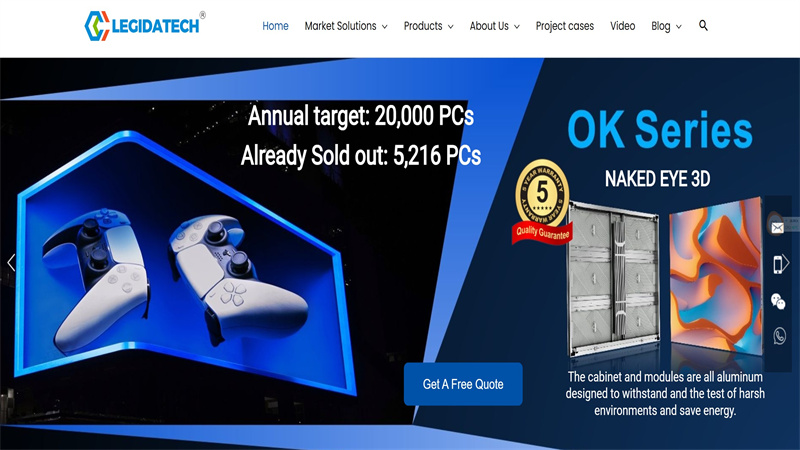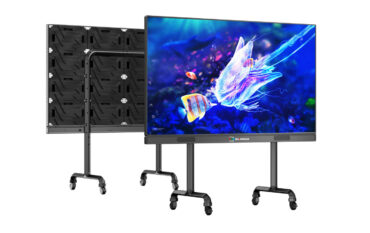Nowadays, the LED display screen is more and more widely applied in our daily. Especially in Shenzhen, when we are walking around the city, we will find outdoor LED screen is everywhere in the parks, in the sports stadiums, and mounts on the buildings.
Big LED screens and 3D LED screens are becoming the trend for the crowed places.
As we all know that, LED display screen is the electronics product, whether it is an indoor or outdoor LED display, it will generate heat when they are working.
For indoor LED display screen, the brightness and the working voltage is lower than the outdoor LED billboard.
Then the heat dissipation will be lower than the outdoor LED billboard.
The increasing of the temperature by the high brightness will affect the light attenuation of the LED display lamp beads, thereby reducing the working efficiency of the driver IC and shortening the service life of the LED display.
Some of the people will doubt if the LED screens need to cool by the air conditioners or the fans during the operation.

Will the high temperature will have impact of the LED Display Screen?
In this article, LEGIDATECH and EXCEL LED will specify the impact of LED display working at high temperature and how to do the maintenance of the LED display screens.
1. The open circuit and failure of LED displays
In some countries such as Middle East, the temperature is very high during the day.
If the working temperature of the outdoor LED billboard exceeds the bearing temperature of the LED chips, its luminous efficiency will be rapidly reduced, resulting in obvious light attenuation and damage.
If the working temperature of the outdoor LED billboard exceeds the load-bearing temperature of the LED chips, the luminous efficiency of the LED display screens will be reduced, there will be very obvious light decline, and the LED billboard is going to have the quality problem very soon.
2. Excessive temperature affects the light attenuation of LED displays
The light attenuation presents the lifespan of LED displays. That is to say, as time goes on, the brightness of the LED displays will be increasingly lower until it dies out.
Generally speaking , the life of LED displays is defined as the time span, during which the luminous flux decreases by 30.
High temperature is the main cause of the light attenuation and the shortening life of LED displays. The light attenuation varies among different brands of LED displays.
Usually, LED display manufacturers will give a set of standard light attenuation curves.
The luminous flux attenuation of LED displays caused by high temperature is irreversible.
The luminous flux before the irreversible light attenuation of LED displays is called the “initial luminous flux” of LED displays.

3. Excessive temperature decreases the light-emitting efficiency of LED displays
As the temperature rises, the concentration of electrons and electron holes will increase, the band gap will be shortened, and the electron mobility will decrease.
As the temperature rises, the radiative recombination probability of electrons and electron holes in the potential well will decrease, resulting in non-radiative recombination (generating heat), thus reducing the internal quantum efficiency of the LED display.
The rise of temperature will move the chip’s crest of blue light towards the direction of long waves, causing a mismatch between the emission wavelength of the chip and the excitation wavelength of the fluorescent powder, and a reduction of the light extraction efficiency outside the white LED display.
As the temperature rises, the quantum efficiency of the fluorescent powder will decrease, leading to less light emission, and the external light extraction efficiency of the LED display will decrease.
The performance of silica gel is greatly affected by the ambient temperature.
As the temperature rises, the thermal stress inside the silica gel will increase, resulting in a decrease of its refractive index, thus affecting the lighting efficiency of the LED display.
4. The effect of temperature will present on the LED display wavelength (light color).
The luminous wavelength of a led display can be generally divided into a peak wavelength and a dominant wavelength.
The peak wavelength is the wavelength with the highest light intensity, and the dominant wavelength can be determined by the X and Y chromaticity coordinates, reflecting the color perceived by the human eye.
Obviously, the repair of the light emitting wavelength of the LED display caused by the junction temperature will directly cause the human eyes to have different feelings on the light emitting color of the LED display.
For a LED display device, the forbidden band width of the light-emitting area material directly determines the wavelength or color of the device’s light.
As the temperature increases, the forbidden band width of the material will decrease, causing the device’s light emission wavelength to become longer and the color to shift red.
5) Excessive temperature will limit the maximum injection current of the LED display.
When buying the outdoor or indoor LED display screens, you should consider about the components of the LED screens such as the LED display chip brand, package manufacturer, driver IC brand, and switching power supply brand.
The quality of all those components will affect the quality of the outdoor and indoor LED displays. For example, the excellent quality decides the power consumption of the LED display screens.

When the LED display screen itself has less heat, It can better control the temperature, thereby extending the lifespan of the outdoor and indoor LED display.
LEGIDA TECH and EXCEL LED outdoor billboard OK series and B10 pro series are with excellent quality and they are the energy-saving models for outdoor application.

They will give their best working performance when working under the high temperature.
LED displays have great development prospects due to their advantages of energy saving, environmental protection and long life.
LED display is relatively sensitive to temperature: it will affect LED display life, light efficiency, color, etc. So the right temperature is crucial for LED displays.
Today, with the increasingly extensive application of LED display, in order to maximize the efficiency of display, application enterprises should have the basic knowledge of LED display maintenance.
Whether it is an indoor LED display or an outdoor LED display, it will generate heat during operation, which will cause the temperature of the LED display to rise.
Author: Cathy
FAQ:
Q: Do you supply energy-saving LED billboard?
A: Yes. In LEGIDA TECH, both our OK series and B10 pro series designed to be energy saving models. We are very confident about our LED screens qualities, we offer 5 years warranty to our clients. If you are working on the outdoor LED billboard project, you can send inquiry to our company.
Q: Should I install the AC for the LED screen when it is in very high temperature place?
A: If your LED billboard screen is very big, and the installation place always under the high temperature. It is better to install the AC, it will help the LED billboard to have a long lifespan.
If the LED billboard screen is small, it is not necessary, the LED billboard have its own fans to make the air circulation between the outer and inner panels.




